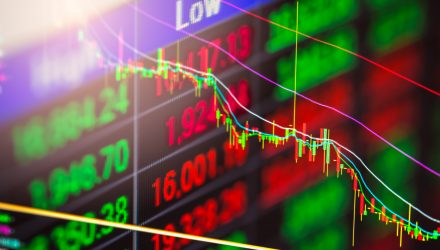Following a first-quarter rebound for U.S. equities, the absence of a trade deal certainly pumped the brakes on a sustained rally in the second quarter. Certain exchange-traded funds (ETFs) were able to capitalize on the return of volatility while others languished amid the market fluctuations.
When markets are oscillating the way they have been recently, a value-oriented tilt is necessary. Based on performance alone, certain ETFs are showing a move to defensive sectors like insurance, but there are also cyclical sectors like home construction that are seeing strong gains in Q2.
As far as those struggling, it’s been the U.S.-China trade wars that have been affecting various sectors across the board. Single-country ETFs like those focused on China are obviously seeing some weakness in Q2.
As such, here are the best-performing ETFs thus far during Q2:
- iShares U.S. Home Construction ETF (BATS: ITB): seeks to track the investment results of the Dow Jones U.S. Select Home Construction Index composed of U.S. equities in the home construction sector. The underlying index measures the performance of the home construction sector of the U.S. equity market. The fund may invest the remainder of its assets in certain futures, options and swap contracts, cash and cash equivalents.
- Invesco Solar ETF (NYSEArca: TAN): seeks to track the investment results of the MAC Global Solar Energy Index. The underlying index is designed to provide exposure to companies listed on exchanges in developed markets that derive a significant amount of their revenues from the following business segments of the solar industry: solar power equipment producers including ancillary or enabling products; etc.
- Invesco KBW Property & Casualty Insurance ETF (NasdaqGM: KBWP): seeks to track the investment results of the KBW Nasdaq Property & Casualty Index (the “underlying index”). The fund generally will invest at least 90% of its total assets in the securities that comprise the underlying index. The underlying index is a modified-market capitalization-weighted index of companies primarily engaged in U.S. property and casualty insurance activities, as determined by the index provider.
On the opposite end of the spectrum, here are the worst-performing:
- VanEck Vectors ChinaAMC SME-ChiNext ETF (NYSEArca: CNXT): seeks to replicate as closely as possible, before fees and expenses, the price and yield performance of the SME-ChiNext 100 Index. The fund normally invests at least 80% of its total assets in securities that comprise the fund’s benchmark index. The index is a modified, free-float adjusted index intended to track the performance of the 100 largest and most liquid stocks listed and trading on the Small and Medium Enterprise (“SME”) Board and the ChiNext Board of the Shenzhen Stock Exchange. The SME-ChiNext Index is comprised of China A-shares.
- Global X MSCI Pakistan ETF (NYSEArca: PAK): seeks to provide investment results that correspond generally to the price and yield performance, before fees and expenses, of the MSCI All Pakistan Select 25/50 Index. The underlying index is designed to represent the performance of the broad Pakistan equity universe. The fund is non-diversified.
- ETFMG Prime Junior Silver ETF (NYSEArca: SILJ): seeks investment results that,correspond generally to the price and yield performance of the Prime Junior Silver Miners & Explorers Index. The index tracks the performance of the equity securities (or corresponding American Depositary Receipts (“ADRs”) or Global Depositary Receipts (“GDRs”)) of small-capitalization companies actively engaged in silver refining, mining, or exploration (“Junior Silver Companies”).
For more market trends, visit ETF Trends.


